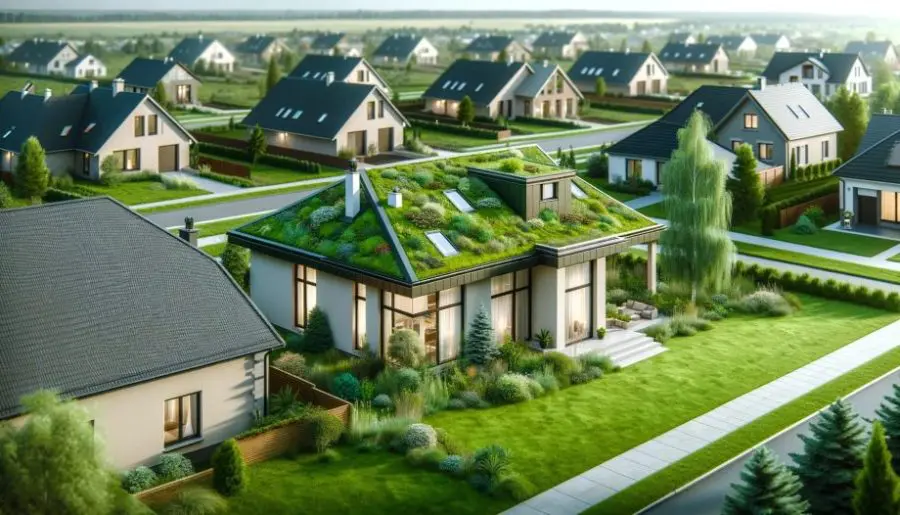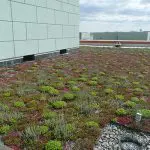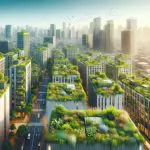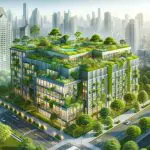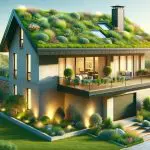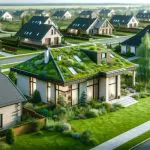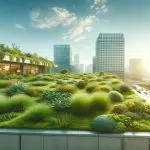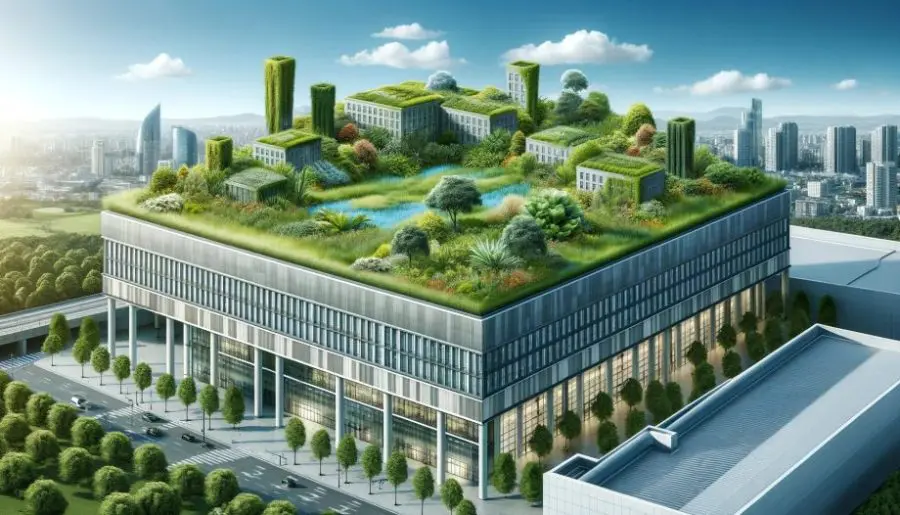
How do green roofs work? They transform urban landscapes! We explain their benefits, installation, and maintenance in an easy-to-understand way.
How Green Roofs Work Key Takeaways:
- How green roofs work is by incorporating layers like waterproof membranes, root barriers, drainage systems, and growing mediums on building tops.
- These layers support plant life, manage stormwater, improve air quality, and provide insulation, thus enhancing urban sustainability and biodiversity.
Ever wondered how do green roofs work? and why they’re becoming a popular addition to urban landscapes.
Join us on a fascinating journey as we explore these eco-friendly oases, delving into their design, benefits, and how they contribute to a greener, more sustainable future for our cities!
How Do Green Roofs Work? Introduction to Green Roofs
In recent years, the concept of green roofs has blossomed into a popular and innovative solution for urban environmental challenges.
The Concept of Green Roofs
At their core, green roofs involve the transformation of conventional rooftops into spaces alive with vegetation.
Environmental and Aesthetic Benefits
This unique blend of architecture and ecology is not just a visual delight; it serves a multitude of purposes, from enhancing urban biodiversity to improving air quality.
Green Roofs in Urban Growth
As cities continue to grow and grapple with environmental concerns, green roofs emerge as a beacon of sustainable urban living.
Unraveling the Green Roof
- Exploring Green Roof Workings: This article aims to delve into how green roofs function and their positive impact on urban ecosystems.
- Comprehensive Overview: We will explore the design intricacies, the range of benefits they offer, and practical implementation considerations.
Who This Article is For
Whether you are an urban planner, an environmentally conscious citizen, or simply curious about this green innovation, this journey through the world of green roofs promises to be enlightening and inspiring.
Understanding Green Roofs and Green Roof Concepts
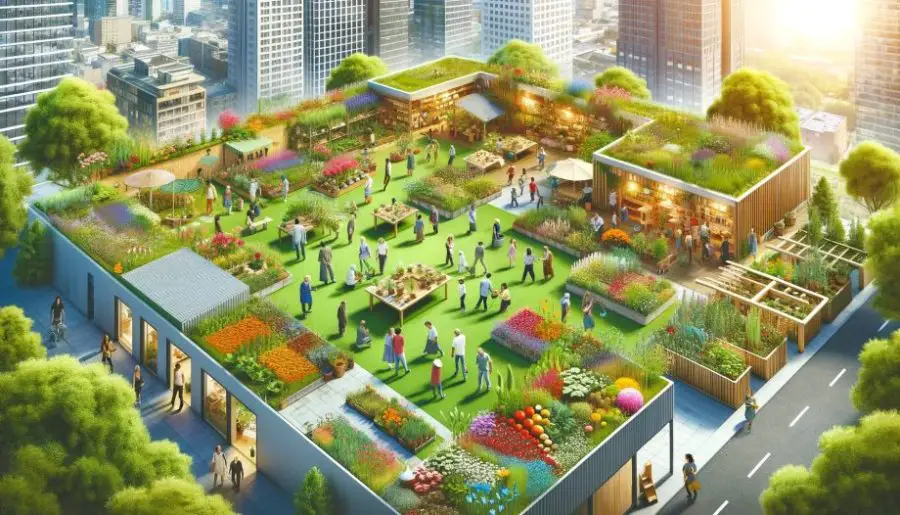
The innovative concept of green roofs represents a significant shift in urban design and sustainability.
These living systems, installed on the roofs of buildings, are more than just a garden in the sky; they are complex structures designed to support plant life and provide various ecological benefits.
This section will dive into the essential elements of green roofs, exploring their types, components, and the principles behind their operation.
Our journey through understanding green roofs will offer insights into how these structures are changing the face of urban landscapes and contributing to a greener, more sustainable future.
A green roof, or rooftop garden, is a vegetative layer grown on a rooftop. Green roofs provide shade, remove heat from the air, and reduce temperatures of the roof surface and surrounding air. EPA
Types of Green Roofs
Intensive vs. Extensive
- Intensive Green Roofs: These are akin to elevated parks and can support a wide range of plant life, including shrubs and even trees. They are characterized by deeper soil layers, typically over a foot deep, which can support a more diverse plant community.
Due to their complexity and weight, they require robust structural support, irrigation, and drainage systems.
Intensive green roofs are ideal for spaces where people can interact with the environment, like rooftop gardens and recreational areas.
- Extensive Green Roofs: These are lightweight and require minimal maintenance, making them suitable for covering large areas where accessibility is not a priority.
They generally have a soil depth of 2-6 inches, supporting hardy, drought-resistant plants like sedum.
Extensive roofs are less expensive and easier to maintain compared to intensive roofs, but they offer limited accessibility and fewer plant varieties.
Applicability and Use Cases
- Intensive Roofs: Commonly used in commercial or public buildings where the roof is intended as an accessible green space. They are suitable for urban environments where ground-level green space is limited.
- Extensive Roofs: Ideal for private residences, industrial buildings, and areas where a low-maintenance solution is needed. They are often used for their environmental benefits rather than as accessible spaces.
Components of a Green Roof
Layer by Layer
- Waterproof Membrane: This is the foundational layer, crucial for protecting the building from water damage. Materials like rubber, thermoplastic, or bitumen are commonly used.
- Root Barrier Layer: This layer prevents roots from penetrating and damaging the waterproof membrane. It is typically made of sturdy, puncture-resistant materials.
- Drainage System: Essential for removing excess water, preventing waterlogging of plants, and protecting the roof structure. It often includes a drainage layer with channels or cups to facilitate water flow.
- Growing Medium: This is a specially formulated soil that is light yet rich enough to support plant growth. It typically includes a mix of organic and inorganic materials such as peat, perlite, and vermiculite.
Material Choices and Functions
- Materials for Waterproofing: Choices vary based on durability, cost, and environmental factors. Modern materials offer longevity and eco-friendly options.
- Root Barrier Materials: Often made from tough plastics or rubber, providing a balance of flexibility and strength.
- Drainage Materials: Lightweight and effective at channeling water, often made from recycled plastics or rubber.
- Growing Medium Composition: Balances water retention with drainage, and supports diverse plant life without being too heavy.
Design and Functionality
Planning a Green Roof
- Load-Bearing Capacity: One of the first considerations in green roof design, ensuring the building can support the additional weight.
- Water Management: Involves designing effective drainage and, for intensive roofs, irrigation systems.
- Plant Selection: Choosing plants based on climate, roof conditions, and maintenance requirements is crucial for a sustainable green roof.
Integration with Building Architecture
- Residential vs. Commercial Buildings: Design considerations differ based on building type, with residential roofs often having less structural capacity than commercial buildings.
- Architectural Compatibility: Green roofs must be designed to complement the existing architecture, considering factors like building height, slope, and style.
The Ecosystem of a Green Roof
Plant Selection and Biodiversity
- Typical Plants: Plants like sedum, grasses, and wildflowers are common. The choice depends on the roof type and local climate.
- Biodiversity Contribution: Green roofs can support a range of insects, birds, and other wildlife, enhancing urban biodiversity.
Creating Microhabitats
- Ecosystem Benefits: Green roofs create habitats for urban wildlife, supporting biodiversity and ecological balance.
- Urban Wildlife: They provide nesting sites for birds and habitat for beneficial insects, contributing to a healthier urban ecosystem.
This detailed exploration provides a comprehensive understanding of green roofs, their components, and their functionality, setting the stage for a deeper look into the benefits and challenges of implementing green roofs in the following sections.
Key Components of a Green Roof

Introduction to Green Roof Structure
Green roofs, in their essence, are marvels of engineering and ecological design, combining multiple layers and components to create a sustainable living system atop urban structures.
Each layer of a green roof has a specific purpose, working together to support plant life, manage water, and protect the building underneath.
In this section, we delve into the anatomy of a green roof, identifying and explaining each critical component and its role in the overall functionality of the system.
Understanding these components is vital for anyone considering the installation or maintenance of a green roof, as each layer contributes to the roof’s effectiveness and longevity.
Waterproof Membrane – Fundamental Protection
- Importance: The waterproof membrane is crucial in any green roof system as it ensures the integrity of the building by preventing water leakage.
- It acts as the first line of defense against water damage, which is essential for the longevity of both the green roof and the building structure beneath it.
Materials and Installation
- Types of Materials: Common materials for waterproof membranes include rubber, thermoplastic, and modified bitumen.
These materials are selected for their durability, elasticity, and resistance to root penetration.
- Installation Process: The installation must be meticulous to ensure no gaps or weaknesses where water could penetrate.
This often involves laying the material across the entire roof surface and sealing all seams and edges securely.
Root Barrier Layer – Preventing Root Penetration
- Protection Role: The root barrier is an essential component that protects the waterproof membrane from being pierced or damaged by growing roots.
This is particularly important for intensive green roofs where deeper rooting plants are used.
- Effectiveness: The root barrier is critical in preserving the waterproofing layer and, by extension, the structural integrity of the building.
Material Choices
- Common Materials: Root barriers are typically made from tough, durable materials like high-density polyethylene (HDPE) or other puncture-resistant fabrics.
- Choosing the Right Material: The choice depends on the type of vegetation planned for the green roof. More aggressive root systems require stronger barriers.
Drainage and Water Retention – Managing Water Flow
- Drainage System’s Role: It is vital for removing excess water from the roof, thus preventing waterlogging of the plants and ensuring the roof structure is not overloaded with water weight.
Effective drainage is key to the roof’s longevity and the health of the plants.
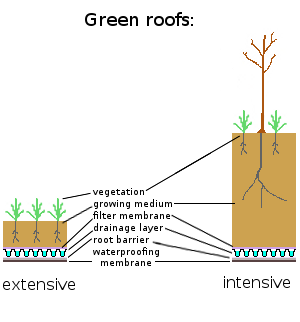
Water Retention Features
- Supporting Plant Life: Some green roof designs include water retention features to maintain moisture levels during dry periods.
These features help in sustaining plant life without the need for frequent irrigation.
Growing Medium – Supporting Plant Life
- Types of Growing Media: The growing medium in green roofs is usually a mix of organic and inorganic materials.
It is engineered to be lightweight yet retain sufficient moisture and nutrients for plant growth.
- Role in Plant Growth: This layer supports the root systems of plants and provides the necessary nutrients for their growth and development.
Composition and Depth
- Composition: Typically consists of materials like peat, perlite, vermiculite, and sometimes recycled materials. It’s designed to balance water retention and drainage.
- Depth Variation: The depth of the growing medium varies depending on the type of green roof.
Intensive green roofs have deeper substrates to support larger plants, while extensive green roofs have shallower substrates suitable for drought-resistant plants like sedum.
Vegetation Layer – Plant Selection
- Criteria for Selection: Plants are chosen based on their hardiness, maintenance needs, and adaptability to the specific climate and roof conditions.
Common choices include sedum, grasses, and various native species.
- Ecological Benefits: The right plant selection contributes to local biodiversity and can even support local wildlife.
Creating a Living Ecosystem
- Diversity and Ecosystem Health: Plant diversity is key to creating a healthy, sustainable rooftop ecosystem. A well-planned vegetation layer can provide habitats for insects and birds, contributing to urban ecological balance.
This comprehensive understanding of the key components of a green roof illustrates how these systems are thoughtfully designed to be effective, sustainable, and beneficial for the urban environment.
This knowledge is indispensable for anyone involved in green roof design, implementation, or maintenance.
Benefits of Green Roofs
Advantages of Green Roofs
Green roofs offer a plethora of benefits that extend well beyond their green facade.
These living systems not only enhance the aesthetics of urban landscapes but also play a significant role in environmental sustainability and urban well-being.
This section aims to explore the diverse advantages of green roofs, ranging from environmental to social and economic benefits.
By understanding the full scope of these benefits, we can appreciate the true value that green roofs bring to urban environments.
Environmental Benefits
- Stormwater Management: Green roofs play a crucial role in managing stormwater in urban areas. They absorb rainwater, thereby reducing runoff and alleviating pressure on sewer systems.
This absorption can also delay the time at which runoff occurs, further benefiting stormwater management efforts.
- Reducing Urban Heat Island Effect: By providing natural insulation, green roofs help mitigate the Urban Heat Island Effect.
This is achieved through the daily dew and evaporation cycle of the plants, which cools cities during hot months and reduces the heat absorbed by traditional roofing materials.
- Air Quality Improvement: The vegetation on green roofs plays a vital role in capturing airborne pollutants and filtering noxious gases. This contributes to an overall improvement in air quality in urban areas.
Economic Advantages
- Energy Efficiency: Green roofs contribute significantly to energy efficiency in buildings. They provide natural insulation, reducing the amount of energy needed for heating and cooling.
This can lead to substantial cost savings over time.
- Increased Roof Lifespan: The protective qualities of green roofs, such as shielding from UV radiation and temperature fluctuations, can extend the life of roof membranes.
This means a longer lifespan for the roof and reduced replacement costs.
Social and Aesthetic Benefits
- Creating Green Urban Spaces: Green roofs transform barren urban roofscapes into vibrant green spaces. They enhance the visual appeal of buildings and contribute to the aesthetic improvement of the urban environment.
- Health and Well-Being: The presence of green spaces, including green roofs, has been linked to improved mental and physical health. They provide urban residents with much-needed access to nature, which can reduce stress and promote well-being.
Biodiversity and Ecological Impact
- Habitat Creation: By supporting a range of plant species, green roofs become habitats for various wildlife, including birds and beneficial insects. This enhances urban biodiversity and contributes to ecological balance.
- Sustainable Urban Ecosystems: Green roofs are part of a larger movement towards sustainable urban development. They help create ecosystems that are more resilient and capable of adapting to environmental changes.
The benefits of green roofs are multifaceted and far-reaching.
From improving air quality to enhancing the aesthetics of urban landscapes, these living systems offer practical solutions to many of the challenges faced by modern cities.
Understanding these benefits is key to appreciating the role green roofs can play in creating more sustainable and livable urban environments.
Installation and Maintenance of Green Roofs
Green Roof Installation and Upkeep
The installation and maintenance of green roofs are crucial aspects that determine their success and longevity.
This section aims to delve into the technicalities of green roof installation, discussing the various steps, considerations, and best practices involved.
Additionally, we will explore the ongoing maintenance requirements, which are essential to ensure that green roofs continue to provide their environmental and aesthetic benefits over time.
Understanding these aspects is vital for anyone considering a green roof project, whether for residential, commercial, or public spaces.
Installation Process of Green Roofs
Initial Considerations
- Structural Capacity: Assessing the building’s structural strength is crucial to ensure it can support the additional weight of a green roof, especially for intensive types that are heavier.
- Local Climate: The climate will dictate the type of vegetation suitable for the green roof and the required insulation and waterproofing measures.
- Intended Use: For green roofs meant as accessible spaces, stronger structural support, and more complex designs are necessary.
Layer-by-Layer Installation
- Waterproof Membrane Installation: This is the first layer, critical for preventing water leakage. It should be durable, and flexible, and cover the entire roof area without gaps.
- Root Barrier Application: Placed on top of the waterproof membrane, it prevents roots from penetrating and damaging the membrane.
- Drainage System Setup: A crucial layer that manages water flow, preventing plant waterlogging and structural damage. It often includes a lightweight, porous material.
- Growing Medium Addition: This layer consists of soil or other growing mediums that are tailored to the needs of the plants being used. It should balance nutrient content with drainage capacity.
- Planting Vegetation: The final step involves planting the selected vegetation, chosen based on the roof type and local climate conditions.
Professional Involvement
- Design and Installation Experts: Hiring professionals with experience in green roof construction is essential for ensuring that the design is structurally sound and meets local building codes.
- Ongoing Consultation: Professional involvement shouldn’t end with installation. Regular consultations can help address any issues and guide maintenance practices.
Maintenance Requirements
Regular Inspections and Upkeep
- Routine Checks: Regular inspections are vital to identify and fix any issues with the waterproof membrane, drainage system, or plant health.
- Addressing Repairs: Timely repairs are essential to prevent minor issues from escalating into major problems.
Irrigation and Fertilization
- Watering Needs: Intensive green roofs might require regular irrigation, especially in dry climates.
- Fertilization Practices: Fertilizing is important to ensure plants receive the necessary nutrients for healthy growth, but it should be done judiciously to avoid over-fertilization.
Weeding and Pruning
- Weed Control: Regular weeding is necessary to prevent unwanted plants from taking over and to maintain the aesthetic and functional aspects of the green roof.
- Pruning for Health and Aesthetics: Pruning helps in maintaining the health of the plants and keeping the green roof looking tidy.
Long-Term Care and Management
Seasonal Considerations
- Changing Needs with Seasons: Maintenance practices may vary with seasons – more watering in dry periods and ensuring proper drainage before rainy seasons.
Lifecycle Management
- Roof Longevity: Over time, aspects of the green roof may need refurbishment or upgrading. This could involve replacing the growing medium, updating the drainage system, or replanting vegetation.
By thoroughly understanding these installation and maintenance processes, stakeholders can ensure that their green roof projects are successful, and sustainable, and continue to contribute positively to urban environments over time.
This comprehensive approach is key to the long-term success and maximization of the benefits that green roofs offer.
Challenges and Limitations of Green Roofs

Introduction to Green Roof Challenges
While green roofs offer numerous benefits, they also come with their own set of challenges and limitations.
This section aims to address these issues, providing a balanced view of green roof implementation.
Understanding these challenges is crucial for anyone considering a green roof, as it helps in making informed decisions and preparing for potential obstacles.
Structural Challenges
- Weight Constraints: One of the primary challenges is the additional weight that green roofs add to buildings. This is particularly significant for intensive green roofs, which require stronger structural support due to their heavier soil and vegetation.
- Building Suitability: Not all buildings are suitable for green roof installation, especially older structures that may not have the necessary load-bearing capacity.
Financial Considerations
- Higher Initial Costs: The upfront costs of installing a green roof are generally higher than those of traditional roofs. This includes the costs of materials, professional installation, and potentially strengthening the existing roof structure.
- Maintenance Expenses: Ongoing maintenance costs can also be a factor, especially for intensive green roofs that require more regular upkeep.
Technical Difficulties
- Complex Installation: Installing a green roof involves multiple layers and systems, making the process more complex compared to traditional roofing. This complexity necessitates the involvement of experienced professionals.
- Waterproofing Challenges: Ensuring a completely waterproof roof can be challenging, and any failure in this aspect can lead to significant damage to the building.
Environmental and Climatic Limitations
- Climate Suitability: Not all types of green roofs are suitable for every climate. In areas with extreme weather conditions, special considerations and adaptations are necessary.
- Biodiversity Limitations: While green roofs can enhance biodiversity, the range of species they support is limited compared to natural ground-level habitats.
Long-term Sustainability
- Durability Concerns: Ensuring the long-term durability of both the vegetation and the roofing materials is a challenge that requires regular monitoring and maintenance.
- Technological Evolution: As green roofing technology evolves, older green roofs may require upgrades or replacements to stay effective and efficient.
Understanding these challenges and limitations is essential for successfully implementing and maintaining green roofs.
It helps stakeholders prepare for potential difficulties and make informed decisions about the feasibility and design of their green roof projects.
While the challenges are significant, they are often outweighed by the long-term benefits that green roofs offer to urban environments.
Real-World Examples and Case Studies

Introduction to Green Roof Success Stories
Exploring real-world examples of green roof projects is crucial in understanding their practical impact.
These case studies not only demonstrate the feasibility of green roofs but also highlight their significant contributions to urban environments and communities.
Let’s delve into some notable green roof projects and their impacts.
Case Study 1: Ford’s River Rouge Plant, Dearborn, Michigan
- Project Overview: One of the largest green roofs in the world, this facility’s roof spans over 10 acres.
- Environmental Impact: It’s designed to minimize stormwater runoff and reduce the urban heat island effect. The roof also helps to save energy costs for the plant.
- Community and Industrial Significance: This project is a pioneering example of sustainable design in industrial facilities, showcasing how green roofs can be integrated into large-scale manufacturing.
Ford Motor Company’s River Rouge Truck Plant – Greenroofs.com
Case Study 2: Vancouver Convention Centre, Canada
- Design and Scale: Features a 6-acre living roof, one of the largest in North America.
- Biodiversity: Home to over 400,000 indigenous plants and provides a habitat for bees, birds, and insects.
- Sustainability Achievement: The roof plays a part in the building’s LEED Platinum certification and demonstrates a commitment to environmental sustainability in urban design.
Vancouver Convention Centre West / Expansion Project – Greenroofs.com
Case Study 3: ACROS Fukuoka Prefectural International Hall, Japan
- Architectural Integration: A unique example where a green roof is integrated into the building’s architecture, creating a large green space in an urban setting.
- Environmental Benefits: The green roof helps in temperature regulation, improving air quality, and creating a green oasis in the city center.
- Cultural Impact: This project is a symbol of blending urban development with nature, offering both aesthetic and environmental benefits to the city.
ACROS Fukuoka Prefectural International Hall – Greenroofs.com
Case Study 4: California Academy of Sciences, San Francisco
- Innovative Design: Features a 2.5-acre living roof with rolling hills and native plant species.
- Educational and Ecological Role: The roof is part of the academy’s focus on environmental education and conservation, providing research opportunities and showcasing sustainable design.
- Energy Efficiency: Plays a key role in the building’s energy-efficient design, contributing to its LEED Platinum status.
Living Roof | California Academy of Sciences (calacademy.org)
Case Study 5: Millennium Park, Chicago
- Urban Transformation: Transformed a former industrial wasteland into a vibrant public park with extensive green roofing over parking garages and rail lines.
- Community Space: The park has become a key community and tourist attraction, highlighting how green roofs can create valuable public spaces in urban settings.
- Multi-functional Design: Features a blend of art, architecture, and nature, exemplifying the innovative use of green roofing in urban redevelopment.
Millennium Park – Greenroofs.com
These case studies represent just a few examples of the innovative and impactful ways green roofs are being used around the world.
They demonstrate how green roofs can be effectively integrated into a variety of building types and urban settings, providing numerous environmental, social, and economic benefits.
How Do Green Roofs Work FAQs
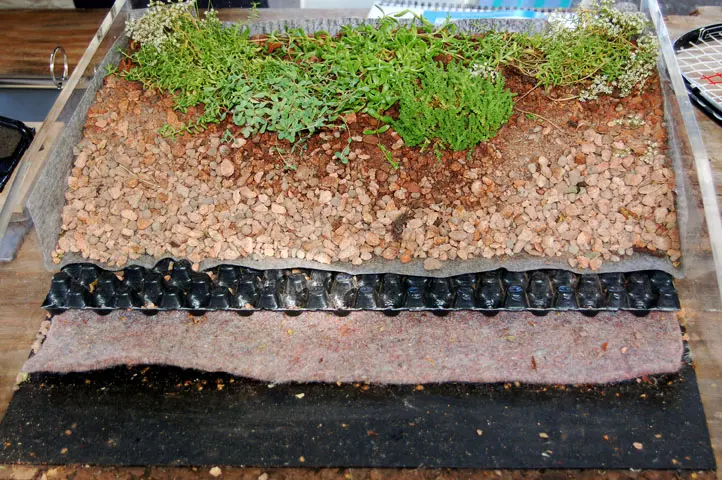
Green roofs are a growing trend in urban development, offering a range of benefits and unique features.
However, they also raise many questions, especially for those new to the concept.
In this FAQ section, we’ll address some of the most common questions about green roofs, providing clear and concise answers to help deepen your understanding of this sustainable technology.
Q: What are the main types of green roofs?
A: There are two main types of green roofs: intensive and extensive.
Intensive green roofs are thicker, can support a wider variety of plants, including trees and shrubs, and are often designed as accessible garden spaces.
Extensive green roofs have a thinner layer of growing medium and are typically home to low-maintenance plants like sedums. They are lighter and require less structural support.
Q: How do green roofs benefit the environment?
A: Green roofs offer numerous environmental benefits. They help manage stormwater runoff, reduce the Urban Heat Island effect, improve air quality, and provide habitats for wildlife.
Additionally, they contribute to energy efficiency by providing natural insulation for buildings.
Q: Are green roofs expensive to install and maintain?
A: The cost of installing and maintaining a green roof varies depending on its type and size.
Intensive green roofs generally have higher installation and maintenance costs due to their complexity and the variety of plants they support.
Extensive green roofs are more affordable and require less maintenance.
While initial costs can be higher than traditional roofs, long-term benefits such as extended roof lifespan and energy savings can offset these costs.
Q: Can green roofs be installed on any building?
A: Not all buildings are suitable for green roofs without modifications.
The suitability depends on the structural capacity of the building to support the additional weight, especially for intensive green roofs.
Older buildings may require structural reinforcement. It’s essential to consult with a structural engineer and a green roof professional before planning a green roof installation.
Q: How do green roofs contribute to urban biodiversity?
A: Green roofs create new habitats for plants and animals, enhancing urban biodiversity.
They provide a refuge for a variety of insects, birds, and other wildlife, especially in densely built urban areas where green spaces are limited.
This increase in green space can help form ecological networks across urban areas, supporting a range of species.
Q: What is involved in the maintenance of a green roof?
A: Maintenance of a green roof includes regular inspections, weeding, pruning, and ensuring the health of the plants.
Intensive green roofs may require more frequent upkeep, including irrigation and fertilization.
Maintenance is crucial to ensure the roof’s functionality and longevity.
Q: Do green roofs have any limitations or disadvantages?
A: While green roofs offer many benefits, they also have limitations.
These include the need for additional structural support, higher initial costs, and the requirement for ongoing maintenance.
In some climates, the choice of plant species may be limited, and ensuring a completely waterproof roof can be challenging.
Q: How long do green roofs last?
A: The lifespan of a green roof can vary, but with proper maintenance, extensive green roofs can last up to 40 years, while intensive green roofs can last over 60 years.
The lifespan is often longer than traditional roofing materials due to the protection the green roof provides to the underlying structure.
Q: Can I install a green roof on my home?
A: Yes, green roofs can be installed on residential buildings, but it’s important to first assess the structural capacity of your home.
Smaller-scale extensive green roofs are more commonly used in residential settings due to their lighter weight and lower maintenance requirements.
Consulting with a professional is recommended to ensure proper installation and compliance with local building codes.
Q: Are there any incentives or support available for installing green roofs?
A: In many regions, there are incentives and support mechanisms for installing green roofs.
These can include tax breaks, grants, and other forms of financial assistance. It’s advisable to research local programs and policies to understand what support might be available in your area.
For more detailed information or specific inquiries about green roofs, you may want to consult with local green roof professionals or visit dedicated resources such as Green Roofs for Healthy Cities.
Conclusion: The Future with Green Roofs
In this exploration of green roofs, we’ve uncovered their multifaceted nature and the myriad benefits they offer.
From their role in enhancing urban biodiversity and mitigating the Urban Heat Island Effect to improving air quality and stormwater management, green roofs stand out as a sustainable solution for modern urban challenges.
They not only contribute to energy efficiency and extend the lifespan of roofing materials but also add aesthetic value and create valuable green spaces in dense urban environments.
What is a Green Roof? 10 Astonishing Innovative Facts
However, it’s important to acknowledge the challenges involved in their installation and maintenance, including structural and financial considerations, and the technical expertise required for successful implementation.
Despite these challenges, the real-world examples we’ve discussed illustrate the transformative impact green roofs can have on communities and urban landscapes.
Call to Action
As we move towards more sustainable and resilient urban development, the integration of green roofs presents an exciting opportunity. Whether you’re an urban planner, architect, or homeowner, consider the potential of green roofs in your next project.
- Learn More and Get Involved: For those interested in learning more about green roofs or considering implementing one, check out resources like Green Roofs for Healthy Cities or https://en.wikipedia.org/wiki/Green_roof for guidance, case studies, and more in-depth information.


